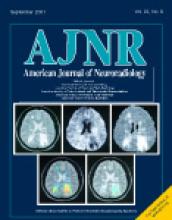I read with interest the article by Griffiths et al published in the AJNR (1), in which the authors describe the early experience with an experimental dynamic MR angiographic method using a contrast agent and a digital mask for cerebral arteriovenous malformation (AVM) assessment. We enjoy Griffiths et al's article because they show again that MR digital subtraction angiography (DSA) is a noninvasive, dynamic angiographic tool. It should be noted that there are missing references in the reference list of the article, and we would like to bring to your attention that MR DSA already could be performed with two frames per second, as described in our February 2000 article in Neuroradiology (2), as well as described by Strecker et al (3, 4). MR-DSA today can be performed with four frames per second when the projection sequence is combined with view-sharing techniques (R. Strecker, personal communication). Post-processing of images in MR-DSA according to the algorithm proposed for functional MR imaging offers several advantages with significant improvement of signal-to-noise ratio of up to a factor of three, background suppression without subtraction, and clear artery-vein separation, even in brain vessels. By the use of these modifications, MR-DSA becomes a promising clinical tool, eg, in the assessment of dural AVMs and brain AVMs. However, all MR-DSA techniques described cannot replace catheter angiography, with its high anatomic and temporal resolution, for planning endovascular therapy.
- Copyright © American Society of Neuroradiology












